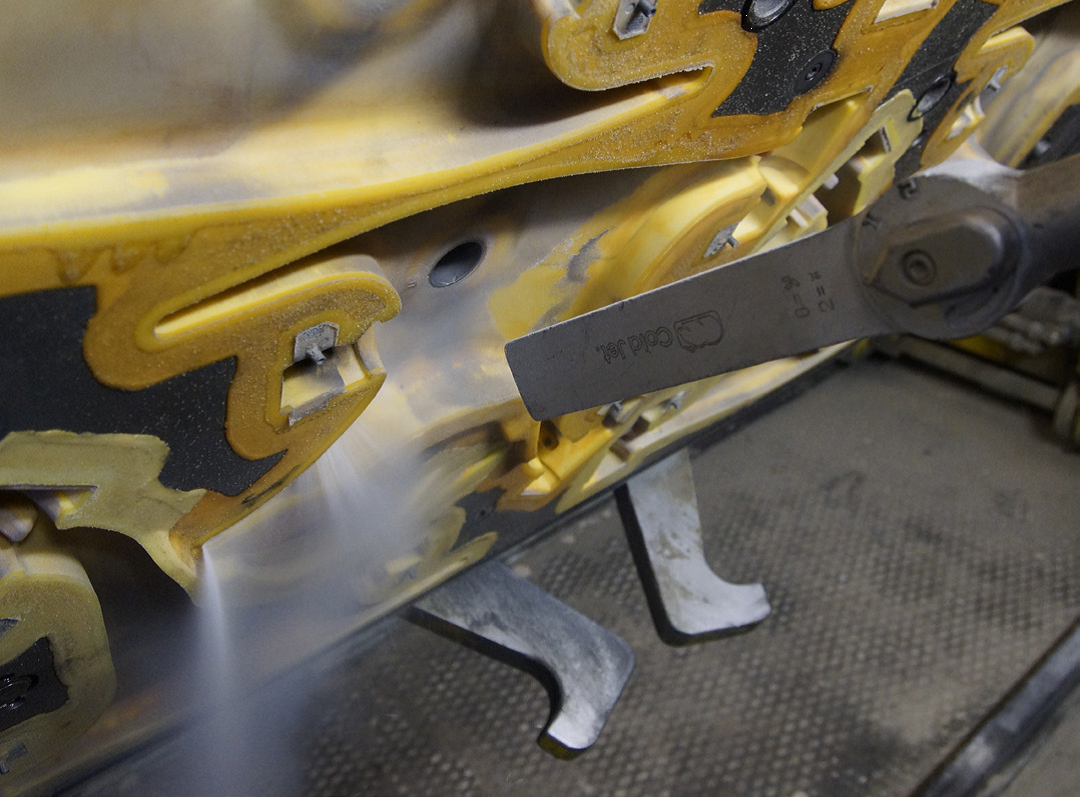
MWS is an aluminum casting and CNC machining specialist that manufactures complex, precise, ready-to-install products in all standard aluminum alloys. The selection of cast aluminum products ranges from highly complex, manually manufactured, made-to-order items to products produced in fully automated manufacturing lines.
Key customer groups include European car manufacturers, the motorcycle and railcar industries and mechanical engineering companies. MWS Friedrichshafen GmbH specializes in aluminum sand casting and is authorized and approved by almost all German car manufacturers as a supplier. One main concern of MWS Friedrichshafen is keeping their core boxes clean. It is crucial in keeping up both quality and integrity.
“The reliable removal of residues of the cold-box binder from the core boxes for the quality of products is of fundamental importance,” said Heiko Gläsle, Foundry Manager at MWS Friedrichshafen. “Therefore, we clean the boxes at regular intervals.”
Core box cleaning with dry ice
Cleaning core boxes is often done with dry ice due to the very complex geometries that require a precise and consistent clean that only dry ice can provide. The company has used dry ice cleaning technology for years because of the many benefits of dry ice, including that it is non-abrasive to the delicate core boxes and it generates no secondary waste in the process, thus no disposal costs.
When compared to manual cleaning methods that require cool down, disassembly, unproductive hours of messy hand cleaning or bead blast cleaning and then reassembly, dry ice saves time and money in production costs and downtime.
In addition, alternative cleaning methods are not fully effective and often result in damage to the part or equipment. Dry ice cleaning offers significant improvement in cleaning times (up to 60%) as well as reduction of damage to equipment and resulting scrap product. As dry ice blasting allows a non-conductive, in-place method to clean parts, even touch-up cleanings are safe and easy.
MWS Friedrichshafen utilizes a Cold Jet dry ice cleaning machine as their solution. In contrast to their previous system, the Cold Jet blaster transports the dry ice and compressed air with a flexible, burst-proof single-hose system to the applicator with an integrated ground wire that protects the employee against electronic discharge/shock during blasting and also prevents against a short circuit.
“The Cold Jet employee arrived with a fully equipped van, so that we could configure and test a blast cleaning system that fitted our requirements,” said Fischer. “The foundry staff had the opportunity to pull the trigger themselves.”
The Cold Jet machine features the patented SureFlow system, which consists of an isolated, insulated hopper, radial feeder, advanced agitation technology, aerodynamic fittings and burst-proof blast hose – which prevents clogging and pellet sublimation and ensures uninterrupted cleaning performance.
“The flexible, single-hose system and the 360 degree turning radius of the Cold Jet blaster provided a significant improvement when compared to handling our previous system,” said Fischer. “We also no longer had dry ice freezing in the supply line or applicator.”
.jpg?width=4974&name=2%20Fallbeispiel%20MWS%20(1).jpg)
MWS Friedrichshafen utilized a wide Cold Jet nozzle for cleaning. Compared to conventional round nozzles, the 25 millimeter wide swath of the nozzle provided better – and thus substantially more – coverage for the surface being cleaned. For delicate and hard-to-reach areas, Cold Jet’s revolutionary line of variable nozzles, with patented MERN technology and patent-pending variable fragmenting technology gives you the power to control aggression in the supersonic flow region of the nozzle - providing a full range of performance with maximum effectiveness. Cold Jet’s design significantly improves reliability because fragmenting occurs downstream for clog-free operation.
The Cold Jet blaster also reduced the problem with high noise volumes due to the multilayer insulation and the reduced volume flow rate of the nozzle.
“We measured the noise level of the old and new unit at 2 workstations,” said Gläsle. “Directly at the site of dry ice blasting at one of our core support centers, the noise level with the Cold Jet system was reduced from 104 to 95 dB(A). At the adjacent workstation near the casting robot, the noise level decreased during blasting from 93 dB(A) to 82 dB(A). Simultaneously at this workstation, we no longer needed to wear earplugs and earmuffs when using the dry ice cleaning equipment, only one ear protection was sufficient.”
Another advantage of the Cold Jet blaster is that the dry ice and air supply can be controlled individually. The dry ice flow rate from 0 to 1,8 kg per minute can be adjusted. The compressed air flow volume is adaptable to the blasting task in a range from 1.4 to 6.1 cubic meters per minute.
“Due to these possibilities, we were able to significantly reduce our dry ice and compressed air consumption from 6 to 4 bar and tune the system exactly to our requirements,” said Gläsle. “The Cold Jet blaster has greatly increased our efficiency with core box cleaning.”
Dry ice blasting leads to increased efficiency
A major issue for the foundry and forging industries is the downtime caused when cleaning permanent aluminum molds, core boxes and vents, die cast machines and tooling, shell core molds, semi-solid castings and conveyors.
Dry ice cleaning offers significant improvement in cleaning times (up to 60%) as well as reduction of damage to equipment and resulting scrap product.
Learn more about the uses of dry ice blasting for the foundry.
-1.jpg?width=6000&name=Fallbeispiel%20MWS%20Friedrichshafen%20(155)-1.jpg)
.png) English
English